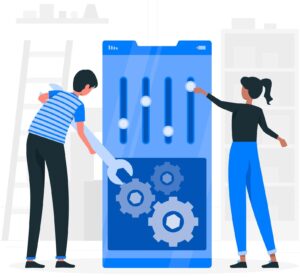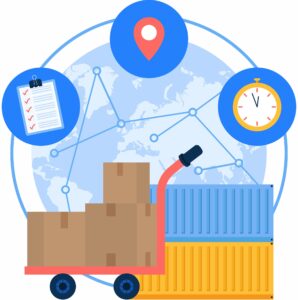7 Ways Textile Technology Solutions are Transforming the Industry
The textile industry is one of the oldest manufacturing industries relying heavily on manual labor and traditional methods. However, over the past 50-60 years, the industry has witnessed drastic changes in terms of adopting advanced technologies. From CAD-CAM to textile ERP systems, and now depending on AI-driven software – the industry has indeed come a long way!
Gone are the days when textile production relied solely on human effort and rudimentary machinery. In this blog, we will explore 7 remarkable ways in which textile technology solutions are reshaping the industry. Be it design, production, quality control, supply chain management – advancing tech is benefiting every aspect of the industry.
That’s not all! Leveraging these technologies, manufacturers are able to achieve higher precision, reduce waste, stay up to date with market trends and promote environmentally friendly practices.
7 Ways Textile Technology Solutions are Transforming the Industry
Here are seven remarkable ways textile technology solutions are transforming the industry by driving efficiency, sustainability, and innovation across every aspect of textile manufacturing:

1] Increased Production Efficiency
Thanks to textile technology solutions, manufacturers have been able to increase their production efficiency manifold. Advanced machinery and automation systems like automated looms, sewing machines, cutting equipment, defect detectors, etc., have significantly streamlined production processes. These machines operate with greater speed than humans and ensure higher precision. This leads to reduced production times and increased output.
As a result, manufacturers are able to:
- Reduce textile waste
- Meet fast-changing customer demands
- Ensure consistent product quality
- Increase cost savings and profit margins
2] Enhanced Customization
With changing times, consumers are more inclined towards investing in customized products. It is reported that 74% of customers are willing to pay more if they get personalized products. To keep up with this textile manufacturing trend, business owners depend on several digital printing and design software systems that aid in manufacturing custom textiles. These technologies enable designers to produce intricate patterns and designs directly onto fabric without the need for traditional screens or dyes.
As a result, manufacturers can:
- Offer personalized clothing, home textiles, and accessories
- Cater to individual tastes and trends
- Stand out in a competitive market with unique products
- Respond quickly to custom orders and limited-edition collections


3] Improved Quality Control
For a long time, the textile industry depended on manual labor for detecting quality issues. Now, with integration of Artificial Intelligence (AI) and Internet of Things (IoT), quality control in textile manufacturing has become much simpler. AI-powered textile ERP systems monitor production processes in real-time, while IoT-enabled devices collect and analyze data, ensuring consistent product quality and minimizing defects.
As a result, manufacturers can:
- Detect and correct defects in real-time
- Maintain high standards of quality throughout the production process
- Reduce the likelihood of costly recalls and returns
- Enhance overall product reliability and customer satisfaction
4] Sustainable Practices and Recycling
Sustainability and ESG adherence are soon becoming mandatory on a global scale. Even consumers are increasingly falling in favor of healthy environmental practices, with almost 84% saying they might give up on a brand if it doesn’t follow ESG practices. Technological advancements have made it easier for textile business owners to keep up with sustainable practices. Innovative recycling techniques convert old textiles into new products, reducing waste and conserving resources. Mechanical and chemical recycling methods break down fabrics into fibers or raw materials for reuse.
As a result, manufacturers can:
- Implement closed-loop systems for continual garment repurposing
- Reduce environmental impact through sustainable manufacturing practices
- Conserve natural resources by recycling and upcycling textiles
- Meet consumer demand for eco-friendly products


5] Better Supply Chain Management
Textile manufacturers deal with a vast supply chain daily, making it difficult for them to track and monitor everything. Moreover, the interdependence of each department necessitates maintaining a smooth supply chain. Textile technology solutions act like a boon, greatly enhancing transparency and traceability in the supply chain. Integration of textile ERP systems and IoT help manufacturers track raw materials from their origin through every stage of production to the final product.
As a result, manufacturers can:
- Improve overall supply chain efficiency and customer satisfaction
- Ensure ethical practices and maintain quality standards
- Optimize inventory management, reducing excess stock and waste
- Respond quickly to market demands and reduce lead times
6] Data-Driven Decision Making
Up to date data plays a crucial role in efficient decision making for a textile business. Back when the textile industry largely depended on manual methods for data collection, it led to delays and errors in data which often impacted business decisions. AI-powered textile ERP systems have solved this problem. Business owners now get access to readymade reports in single dashboards that allow easy analytics and facilitate data-driven decision making. By collecting and analyzing vast amounts of data, manufacturers can gain valuable insights into process efficiency, quality control, and consumer preferences.
As a result, manufacturers can:
- Identify patterns and trends to inform production schedules and inventory management
- Implement predictive maintenance strategies to prevent equipment failures
- Align production with market needs through demand forecasting
- Make informed decisions that drive business growth and cost savings


7] Faster Time-to-Market
When all aspects of the textile manufacturing business are aligned well, and things move smoothly from one department to another – it makes it easier for manufacturers to reduce their overall turn-around-time (TAT). Businesses have recorded improving their delivery timelines by 20-30% with the help of textile ERP systems. In addition, technologies like 3D printing and digital sampling enable rapid concept creation and testing, allowing manufacturers to respond swiftly to emerging textile manufacturing trends.
As a result, manufacturers can:
- Quickly create and test new designs without traditional prototypes
- Implement just-in-time production for efficient manufacturing and prompt delivery
- Bring new products to market faster, gaining a competitive advantage
- Enhance customer satisfaction with timely product launches and innovation
The future of the textile industry is bright, thanks to continuous advancements in technological solutions that are driving innovation and efficiency. With the integration of sophisticated textile ERP systems, AI-powered analytics, and cloud-based platforms, manufacturers can look forward to a future where operations are more streamlined, sustainable, and responsive to market demands.
As textile technology solutions become more intelligent and interconnected, the industry will see even greater improvements in customization, quality control, and supply chain management. Ultimately, these advancements will empower manufacturers to meet evolving consumer expectations, reduce environmental impact, and maintain a competitive edge in the global market.

